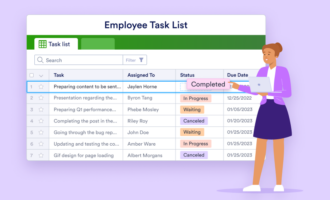$90 billion.
That’s how much US-based companies spent on employee training and development in 2017.
I was astonished by this figure — and it made me think about how we can all improve our training and employee retention.
In my experience, it always comes back to company culture.
For example, I recently discovered Etsy School.
Employees at the e-commerce company run a series of courses where they teach each other new skills. And they’re not just work-related activities, either. The courses include everything from coding and sewing to dancing the tango and mixing cocktails.
I love this idea.
Not just because staff can learn a variety of skills, but also because it brings people together in a light-hearted, yet informative setting.
When employees are engaged with their workplace, studies have shown that productivity increases and the costs associated with training and employee turnover drop dramatically. And these costs are some of the most challenging for businesses to overcome.
That’s because training programs are difficult to get right. Programs often face time constraints, limited budgets, and a lack of enthusiasm, particularly when they fail to target employees’ individual limitations and opportunities for growth.
While many businesses are investing in vast, company-wide training programs, it’s worth considering how culture can do some of the heavy lifting.
In the end, a culture that focuses on individual needs and helping people grow might just deliver as much value as pricey courses and training programs.
Training will help your staff — but only when it’s needed
At my company, Jotform, we appreciate that each of our employees has different peak hours. And because we respect their time — both inside and outside the office — we try our best to keep normal working hours.
Therefore, when we offer employee training, the programs have to be both valuable and stimulating for everybody involved.
We don’t want to waste a minute of our employees’ time. But research suggests this isn’t easy to accomplish.
A McKinsey study that surveyed 1,440 executives across a variety of industries found that just one quarter believed their training strategies benefited the company’s overall performance.
If we combine those findings with the idea that employees have less time for learning than ever before — only 24 minutes per week to be exact — it seems clear that we need to develop a responsive culture that serves individual needs.
For example, our company has grown to over 130 employees over the past 12 years, but by splitting our staff into small, cross-functional teams, we can respond quickly to the diverse needs of each person.
Every group functions as its own little company, independent and empowered to make decisions. And because we concentrate on the needs of each team, we’re not wasting resources by training the wrong people for the wrong task.
We don’t always get it right, but we do want our employees to feel like the training benefits them on a personal level. And by identifying weaknesses in our workforce and scoping out what’s required for upcoming projects, we can develop a strategy that simultaneously addresses both needs.
Engaged employees are less likely to leave
Richard Branson once said,
“Train people well enough so they can leave, treat them well enough so they don’t want to.”
Many business leaders have spent sleepless nights worrying that their best employees will resign when another opportunity comes up.
I can relate. Recruitment and training aren’t cheap, plus an unsettled team simply can’t function at its maximum capacity.
But as I’ve shared before, if we provide an engaging workplace and treat our employees with respect, there shouldn’t be anything to worry about.
Fostering an employee-friendly corporate culture goes far beyond a few games of ping-pong. It’s not easy (especially as a company grows), but at Jotform, we work hard to maintain our collaborative roots, while also encouraging casual initiatives — like our demo days, where teams present their work in an informal, stress-free setting.
I’ve found this brings our team closer, while still emphasizing the need for high-quality results. And it seems to be working. Last year, I crunched the numbers and found that our annual employee churn rate has dropped to 5%.
I share this number not to wave our flag, but to encourage other entrepreneurs, managers, and business owners. Investing in culture really does matter — and it can pay real dividends. I also encourage others to hire slowly and carefully consider each move.
Across every industry, we should also try to ensure people know that they can always suggest ideas, provide feedback, and truly, there are no stupid questions.
Be confident in your employees. If you develop a space that encourages learning and progress, most people will be eager to stick around.
Create a culture where everyone can thrive
During our first five years in business, I worked closely with the same four employees. We were a tight-knit crew that collaborated on the same projects and spent our lunch breaks together.
It also meant that problems could be resolved quickly.
But as soon as we started to grow, I noticed some cracks beginning to form.
When the team reached 15 employees, and then 28 a year later, I realized we weren’t as sharp as we once were. Our communication wasn’t as seamless and the camaraderie we once had wasn’t as familiar.
It’s an all too common story for a growing business.
How do we overcome this?
By building a culture that supports our employees and always encourages learning.
For example, every new hire goes through a bootcamp period where they handle at least 100 customer support requests during their first month on the job.
This way, each team member has time to understand our customers: what they need, how they struggle, and most importantly, how we can improve.
Typically, new employees also have lots of questions. To help put their minds at ease, we team them up with an experienced developer, designer or marketer for at least two hours per day.
And when I have the chance, I take our newest employees out to lunch. We can get to know each other in a casual setting, and I also find that it helps to dissolve any barriers or awkwardness we might feel.
Develop strong support systems
Culture is never static, and fostering a healthy workplace is never a one-size-fits-all situation.
None of the approaches I’ve shared will break the bank. But they can go a long way toward helping employees feel empowered and settled in their workplace.
If our team members are excited to arrive at the office each day, then we’re doing something right.
While other companies focus on training staff in every way imaginable, consider how developing the right support systems might give you a greater advantage.
Sure, your employees might not be learning the tango or shaking cocktails during work hours, but you can provide a great setting for your employees to thrive — all without spending a fortune.
































Send Comment: